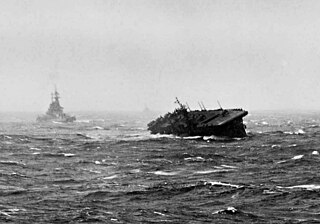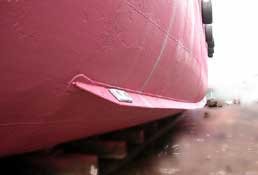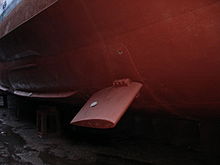
A gyroscope is a device used for measuring or maintaining orientation and angular velocity. It is a spinning wheel or disc in which the axis of rotation is free to assume any orientation by itself. When rotating, the orientation of this axis is unaffected by tilting or rotation of the mounting, according to the conservation of angular momentum.
Stabilizer, stabiliser, stabilisation or stabilization may refer to:

Elmer Ambrose Sperry Sr. was an American inventor and entrepreneur, most famous for construction, two years after Hermann Anschütz-Kaempfe, of the gyrocompass and as founder of the Sperry Gyroscope Company. He was known as the "father of modern navigation technology".

A water rocket is a type of model rocket using water as its reaction mass. The water is forced out by a pressurized gas, typically compressed air. Like all rocket engines, it operates on the principle of Newton's third law of motion. Water rocket hobbyists typically use one or more plastic soft drink bottle as the rocket's pressure vessel. A variety of designs are possible including multi-stage rockets. Water rockets are also custom-built from composite materials to achieve world record altitudes.

Technical research ships were used by the United States Navy during the 1960s to gather intelligence by monitoring, recording and analyzing wireless electronic communications of nations in various parts of the world. At the time these ships were active, the mission of the ships was covert and discussion of the true mission was prohibited. The mission of the ships was publicly given as conducting research into atmospheric and communications phenomena. Their designation was AGTR – Auxiliary, General, Technical Research – but it was more or less an open secret that this was a euphemism and they were commonly referred to as "spy ships".
Ernst Otto Schlick was a German naval engineer. He tried to solve the problem of rolling of ships at sea by installing large gyroscopes. The gyroscopic "stabilizers" gave disappointing or dangerous results in practice. An Englishman before him in 1868, Henry Bessemer had tried to use hydraulics and a spirit level watched by the steersman to stabilize ship rolls, also with dangerous results.

Image stabilization (IS) is a family of techniques that reduce blurring associated with the motion of a camera or other imaging device during exposure.

Ship motions are defined by the six degrees of freedom that a ship, boat, or other watercraft, or indeed any conveyance, can experience.

USS Glover (FF-1098) was a Garcia-class frigate originally modified for research use and commissioned as (AGDE-1) on 3 November 1965. Glover was laid down 29 July 1963 by the Bath Iron Works, in Bath, Maine and launched on 17 April 1965 with sponsors Mrs. William S. Pederson, Sr., and Mrs. Claude V. Signer, great-great-great-granddaughters of General John Glover.

Ship stabilizing gyroscopes are a technology developed in the 19th century and early 20th century and used to stabilize roll motions in ocean-going ships. It lost favor in this application to hydrodynamic roll stabilizer fins because of reduced cost and weight. However, since the 1990s, there is renewed interest in the device for low-speed roll stabilization of vessels. Unlike traditional fins, the gyroscope does not rely on the forward speed of the ship to generate a roll stabilizing moment and therefore can stabilize motor yachts while at anchor. However, the latest generation of "zero speed" fins stabilizers can stabilize yachts while at anchor thanks to their eccentricity with respect of the shaft.

Ship stability is an area of naval architecture and ship design that deals with how a ship behaves at sea, both in still water and in waves, whether intact or damaged. Stability calculations focus on centers of gravity, centers of buoyancy, the metacenters of vessels, and on how these interact.

A bilge keel is a nautical device used to reduce a ship's tendency to roll. Bilge keels are employed in pairs. A ship may have more than one bilge keel per side, but this is rare. Bilge keels increase hydrodynamic resistance, making the ship roll less. Bilge keels are passive stability systems.
Stabilisation while not underway, stabilisation at rest, zero-speed stabilisation or on-anchor stabilisation is the process of augmenting roll reduction for a vessel that is not underway. This process may in some cases be implemented through the use of equipment systems that are also used for roll stabilisation while underway.

The Almirante Clemente class of destroyer escorts is a class of warships built for several countries. The class was designed by Ansaldo for the Venezuelan Naval Forces, currently Venezuelan Navy, in the 1950s to complement its Nueva Esparta-class destroyer.

Ship gun fire-control systems (GFCS) are analogue fire-control systems that were used aboard naval warships prior to modern electronic computerized systems, to control targeting of guns against surface ships, aircraft, and shore targets, with either optical or radar sighting. Most US ships that are destroyers or larger employed gun fire-control systems for 5-inch (127 mm) and larger guns, up to battleships, such as Iowa class.
Antiroll tanks are tanks fitted onto ships in order to improve the ship's response to roll motion. Fitted with baffles intended to slow the rate of water transfer from the port side of the tank to the starboard side and the reverse, the tanks are designed such that a larger amount of water is trapped on the higher side of the vessel. This is intended to reduce the roll period of the hull by acting in opposition to the free surface effect. They can be broadly classified into active and passive antiroll tanks.

A rolleron is a type of aileron used for rockets and used to provide passive stabilization against rotation. While most commonly used to stabilize against roll, it can also be used for counteracting yaw and pitch as well.

Nicolas Minorsky was a Russian American control theory mathematician, engineer and applied scientist. He is best known for his theoretical analysis and first proposed application of PID controllers in the automatic steering systems for U.S. Navy ships.
A Gyroscopic stabilizer is a control system that reduces tilting movement of a ship or aircraft. It senses orientation using a small gyroscope, and counteracts rotation by adjusting control surfaces or by applying force to a large gyroscope. It can be:
A gun stabilizer is a device that facilitates aiming an artillery piece by compensating for the motion of the platform on which it is mounted. For naval applications see ship gun fire-control system. Moving land-based systems tend to require more specialized stabilization. Due to the need to fire while in motion, tanks in World War II made some use of stabilization, but it became commonplace in later decades during the Cold War.
















